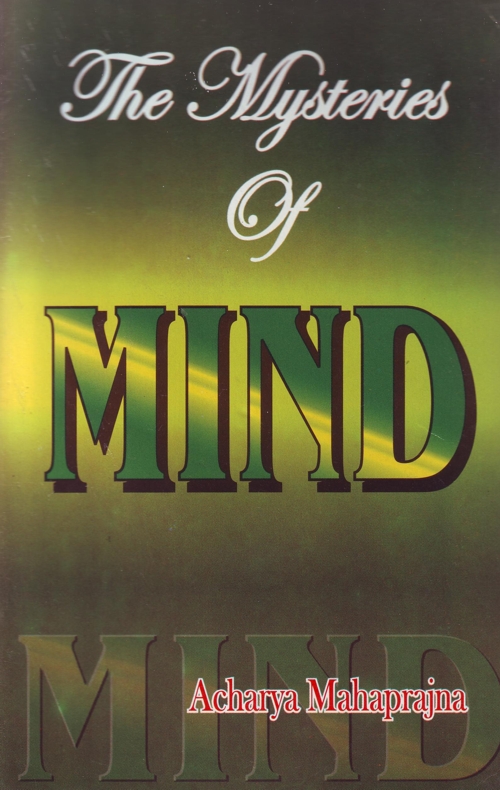
However, it should not be supposed that the artificial modifications can be stopped as soon as we sit down to meditate. We go on witnessing various kinds of processes even during meditation. It has been found that a state of meditation is in many respects similar to the state of complete rest or relaxation. The human body contains an acid known as leptic acid. Its secretion in a state of rest is very small. In the state of meditation it is still smaller. Its decrease after an eight hours' sleep is equal to its decrease after a twenty minutes' meditation. This acid is harmful for the body. Many other things happen during meditation. Mental processes do not completely stop during meditation. They continue even in a vitaraga (passionless) state. The kevali jnani (possessor of pure knowledge) is also not beyond them. Gautama asked Bhagavana Mahavira, '"Can a kevala jnani put his hand twice on the same thing?" Mahavira replied, "No, he cannot." Gautama again asked, "How is it not so?" Mahavira answered, "Gautama, the body is often changing. It is not constant. The kevali has a body, and therefore, he cannot put his hand twice on the same print space. Space points go on shifting." Thus even a possessor of pure and absolute knowledge is not beyond physical and mental processes. A two-three hours meditation cannot take you beyond these processes. When the practitioner arrives at a state known as sailesi, which happens in the last or fourteenth stage of spiritual (meditational) progress, he enters into a state, which is beyond mental and physical process. This state is nearest to the state of emancipation. In this state the soul becomes free from all kinds of artificial modifications and becomes motionless. This state is the ideal of our pilgrimage. We can arrive at this state through meditation. If these processes could be stopped even for a few moments, the moments should be construed as moments beyond mental and physical processes. They encourage us to proceed towards our ideal.
We live in the gravitational field of the earth. If we could enter into a state of weightlessness even for a few moments, we would think that life has begun a new for us.
We have either good thoughts or evil thoughts or no thoughts at all in our minds. Similarly we do either good deeds or bad deeds or no deeds at all. Thoughts are mental processes. As processes they do not differ from each other. Both are waves. Generally we believe that physical objects have colour, form, sound, beat, etc. A scientist does not think in these terms. For him objects have neither colour nor form nor sound nor heat. He thinks of the world in terms of time and energy. The world is a process of energy in time. Energy is the substance of which the entire universe is made. Therefore, thinking, whether we think good or bad thoughts, is a process of energy. If our purpose is to arrive at a state beyond these processes, the first thing we have to do is to rescue ourselves from bad processes and to swim with the good processes. Swimming with the bad processes takes us away from our goal, which is the obliteration of all activity.
Lesya meditation is the easiest means of swimming with the good current. You cannot turn your thoughts in the right direction without this meditation. Social relations are the breeding ground of all kinds of evils, more especially mental evils. They force us to react. We cannot get rid of the life of reactions without meditating on auspicious colourations (lesya). There are three auspicious lesya called taijasa (deep red), padma (pink) and sukla (white). We can change our mentality by meditating on these lesyas. With the change of mentality these colours also begin to change. The outer world then begins to influence the inner world and vice versa.
Thoughts are produced either by internal tendencies by sounds prevailing in the sky. Pudgal (material) particles of sound enter into our mind and produce thoughts. Take, for example, a group of persons sitting together. There maybe good or bad men among them. The thoughts of the good men spread in the sky and influence the entire company. In the same way those of the bad men also influence the whole company. This influence is due to the force of thoughts. Pudgala particles emerging from the mind spread in the sky. They strike the minds of other men and influence them. That is why it has been said that one should keep company with good men only.
The Acaranga says, "Don't keep company with bad men." To avoid the effects of bad thoughts we have to take precautions. The first is to subdue bad tendencies. Meditation of taijasa and padma lesyas purifies mental tendencies. The second is not to allow evil thoughts to arise in our minds. Meditation on the sukla lesya stops the rise of such thoughts. Meditation on the white colour wards off evil thoughts, which enter into our minds from outside. Meditation on red and yellow colours stops evil thoughts, which rise from within the mind itself. Once we have shielded ourselves from external and internal sources of thoughts, our minds become the abode of good thoughts only, which are helpful to us in our spiritual pilgrimage. Although lesya itself is a wave, yet it carries us to a state of calm.
Perceptive meditation on breath enables us to control it. Perceptive meditation on the body enables us to perceive the vibrations of the body and the perishable nature of them. This perception leads us to contemplative meditation (anupreksa) on the transitory character of the world. Here begins the search for the immutable, which leads to the next stage of perceptive meditation on the centres of consciousness, which is a source of enlightenment.
There are two centres of the manifestation of the transcendental soul in our body, the brain and the centres of consciousness. It is through these centres that the soul sends forth the rays of its light on the outer world. The practitioner who meditates on the centres of consciousness comes face to face with the light of the soul. Once he has got a glimpse of this light, he will never go astray. Even a short experience of calm and a few moments of right perception will be enough to lead him to his goal. Let us know the real nature of things through anupreksa (contemplation). False perception results in ignorance, which goes on increasing by its own force and precludes our vision. It is through contemplation that we can destroy it. There are five means of arriving at the transcendental state of calm:
- Breath perception (svasa preksa).
- Body perception (sarira preksa).
- Contemplation (anupreksa).
- Lesya (colour) meditation.
- Kayotsarga (abandonment of the body).
These are the five bases of preksa meditation. They need a lot of self-exertion, a long and concentrated exertion.
Practice of breath perception will make you feel that your body is becoming lighter. Meditation on pure lesyas also has the same effect. It is the impure lesyas, which make the body heavy and lethargic. Pure lesyas produce mild sensations. They make us feel a state of weightlessness. They change the odours of the body while impure lesyas produce bad smell. The body of a man who harbours evil thoughts emits bad smell. The body of a man who entertains good thoughts smells sweet. It is through the odours of the body that we can infer whether a man is good or bad. Our mouths also taste sweet or sour or bitter due to the effective vat (wind), pitta (bile) and kapha (phlegm). They affect our thinking also. Bile produces anger, wind complicates thinking and phlegm combining with wind and bile affects thoughts, which in their turn affect all the three humours.
Kayotsarga winds up all the physical and mental processes including evil thoughts.
It is now for us to decide whether we would like to be tossed to and fro in the ocean of empirical experience of rest in a state of transcendental calm.
 Acharya Mahaprajna
Acharya Mahaprajna

